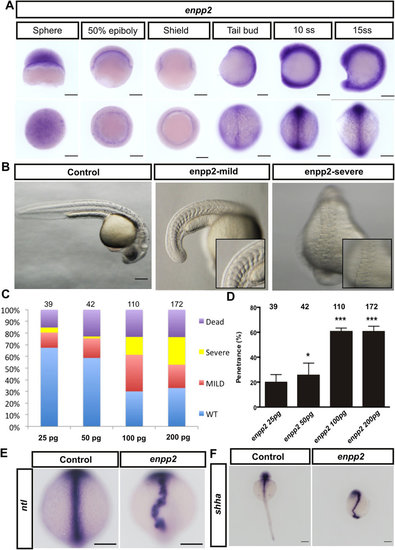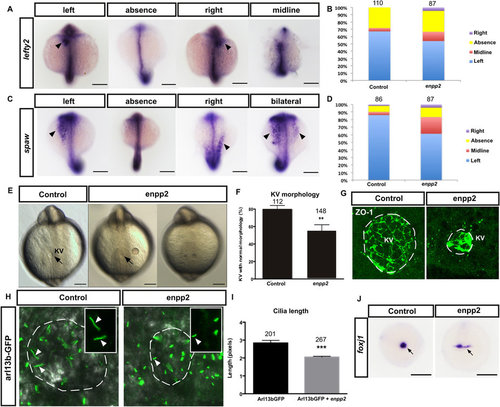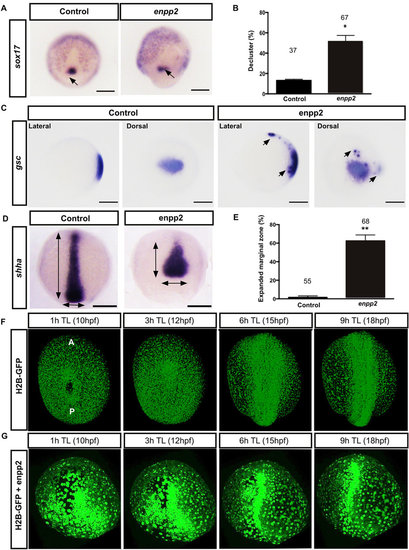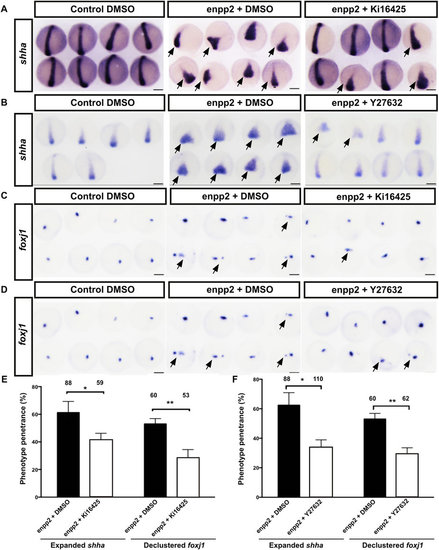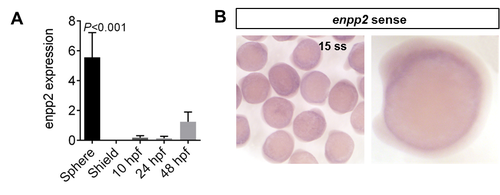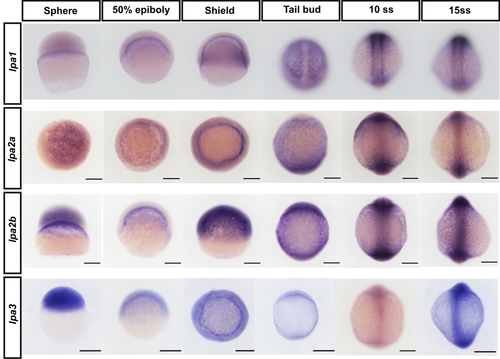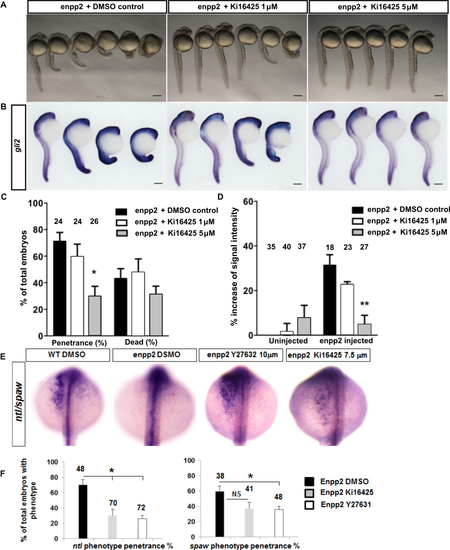- Title
-
Role of ectonucleotide pyrophosphatase/phosphodiesterase 2 in the midline axis formation of zebrafish
- Authors
- Frisca, F., Colquhoun, D., Goldshmit, Y., Änkö, M.L., Pébay, A., Kaslin, J.
- Source
- Full text @ Sci. Rep.
|
Enpp2 overexpression alters midline axis formation in the early embryogenesis of zebrafish. Developmental series of WISH at designated stages were performed using enpp2 antisense riboprobe. (A) Lateral view and animal/dorsal view of WISH early zebrafish embryos at designated stages. (B) Representative pictures of control, mild (slight delay and smooth somite borders) and severe (developmental delay and midline axial defect) phenotypes in enpp2 injected embryos. (C,D) Quantification of phenotype variant and penetrance (detectable phenotype) following injection with different doses of enpp2 RNA and normalized to control. The sample size (n) is stated as numerical value above each bar. Data are mean ± SEM from at least four independent experiments. Statistical analysis was established by one-way ANOVA; *P < 0.05; ***P < 0.001. Dead embryos were normalised to uninjected embryos (E) Representative WISH pictures of control and enpp2 injected embryos with midline axis gene probes ntl or shha riboprobes (F). >50 embryos used in each experiment. Scale bars: 200 μm. EXPRESSION / LABELING:
|
|
Enpp2 modulates nodal-related asymmetry gene expressions, KV formation and ciliogenesis. Representative images of WISH of the control and enpp2-injected zebrafish embryos at 15–21ss with lefty2 (A) and spaw (C) antisense riboprobes respectively. The midline/notochord is highlighted by ntl expression. The determination of left, bilateral, absence, and right groups was based on the location of lefty2 or spaw expression compared to ntl (midline). The quantification of lefty2 and spaw expression distribution embryos is shown in (B) and (D) respectively. (B) The proportion of lefty2 expression on the left, bilateral, absence and right side are 67.3%, 4.5%, 28.2%, and 0% respectively in the control embryos and 54%, 12.6%, 28.7%, and 4.6% respectively in the enpp2 overexpressed embryos. (D) The proportion of spaw expression on the left, bilateral, absence and right side are 86%, 4%, 8%, and 2% respectively in the control embryos and 61.3%, 21.8%, 12.7%, 4.2% respectively in the enpp2-overexpressed embryos. (E) Representative images of the KV morphology in control- and in enpp2 overexpressing embryos (5–8ss). (F) Quantification KV size in enpp2 overexpressed embryos compared to control. (G) Whole-mount antibody staining of zona occludens 1 (ZO-1) that labels cell junctions and outlines the KV in control enpp2 injected embryos. (H) Representative confocal Z-stack images of cilia in the KV, marked with arl13b GFP, highlighting cilia morphology and distribution in control- and enpp2 overexpressing embryos at 5–8ss. (I) Quantification of the cilia length between control- and enpp2 overexpressing embryos. The sample size (n) is stated as numerical value above each bar. Data are mean ± SEM Statistical analysis was established by t-test; ***P < 0.001. n indicated above bars. White circles highlight the KV lumen. (J) Enpp2 overexpression altered the expression pattern of foxj1, a master regulator of ciliogenesis, observed at 90% epiboly embryo. |
|
Enpp2 overexpression induces alteration in cellular migration, the expression pattern of KV precursors, dorsal organizer and midline genes (gsc and shha) during early embryogenesis. (A) Representative images of WISH with sox17 riboprobe to mark the integrity of the DFC cluster at 75% epiboly. (B) Quantification of KV defect and/alteration of DFC cluster, as highlighted by sox17 WISH. (C) The gsc expression is observed in the dorsal organizer of enpp2 overexpressing embryos. However, the expression is also detected in the axial mesoderm precursors suggesting that convergence and cell migration during midline formation is impaired. (D) Representative images of WISH of shha at 90% epiboly showing a truncated axis and laterally expanded expression of shha at the blastomderm margin. (E) Quantification of the broadened shha expression domain at the blastoderm margin in control and enpp2 overexpressing embryos at 90% epiboly. (F,G) Representative images of time lapse series showing cell migration during midline formation (10 hpf- early somitogenesis) in wild type and enpp2-injected embryos. Image stacks were taken every 15 minutes. Time course for each image is indicated. The enpp2 overexpressed embryo failed to undergo a proper CE (G) which results in bend and broadened midline compared to wild type (F). (B,E) The sample size (n) is stated as numerical value above each bar. Data are mean ± SEM. Statistical analysis was established by t-test; *P < 0.05; **P < 0.01. n indicated above bars. |
|
Pharmacological blocking of lpa1–3 or Rho/ROCK signalling rescue enpp2 overexpression induced midline phenotype. Representative WISH images of shha (A,B) and foxj1 expression (C-D) at 90% epiboly of enpp2 overexpressing embryos treated with the lpa1–3 antagonist Ki16425(A,C) and Rho/ROCK signalling inhibitor Y27632 (B,D). Enpp2 overexpressing embryos display expanded expression of shha (A,B) and foxj1 (C,D) illustrated by pointed in arrows. Quantifications of the of shha expression domain in enpp2 overexpressing embryo following vehicle or Ki16425 (E) or Y27632 treatment (F). The phenotype penetrance following enpp2 injection and Ki16425 treatment and Y27632 were measured at 90% epiboly (E,F). (E,F) The sample size (n) is stated as numerical value above each bar from at least two independent experiments. Data are mean ± SEM. Statistical analysis was established by t-test; *P < 0.05; **P < 0.01. n indicated above bars. |
|
A. enpp2 overexpression measured by RT-PCR in the early embryogenesis of zebrafish. Developmental series of RT-PCR at designated stages were performed using enpp2 Taqman® probe. Data are mean ± SEM. Statistical analysis was established by one-way ANOVA; * P < 0.05; ** P < 0.01. B. In situ hybridisation of enpp2 at 15 somite stage embryos (ss) using sense probe showing no specific signal in comparison to embryo hybridised with antisense probe (see Figure 1 A). |
|
Expression pattern of enpp2 and lpa1-3 by WISH. Developmental series of WISH at designated stages were performed using enpp2 and lpa1-3 antisense riboprobe. Lateral view and animal/dorsal view of WISH early ZF embryo at designated stages. Scale bars: 200 μM. EXPRESSION / LABELING:
|
|
Antagonizing lpa1-3 using Ki16425 rescues the enpp2-overexpressed phenotypes. Representative bright field (A) and WISH images with gli2 riboprobes (B) of rescued experiments using Ki16425; in control (immersed in vehicle), Ki16425 (1 and 5μM) at 24hpf. The phenotype penetrance following enpp2 injection and Ki16425 treatment were measured at 24hpf (C, D). Following enpp2 overexpression, the phenotype observed was 71.1 ± 3.6 % in the vehicle control, 59.5 ± 9.5 % in Ki16425 1 μM, and 29.8 ± 7.5 % in Ki16425 5 μM. (C, D). E-F. Rescue experiments in enpp2 overexpressing embryos with Ki16425and Y27632 using ntl and spaw WISH as readout at 24 hpf. Following enpp2 overexpression, the ntl phenotype (notochord defects) was 70 ± 7.1 % in the vehicle control, 30± 8.5 % in Ki16425 7.5 μM, and 26 ± 4.3 % in Y27632 10 μM. spaw is normally expressed on the left side of the midline. The spaw expression phenotype (Figure 2 C, no expression, bilateral expression or expression on right side of the midline) was rescued in 36 ± 4.3 % of the Y27632 treated enpp2 overexpressing embryos. There was no significant rescue of spaw expression in Ki16425 treated embryos, although a clear trend was detected. Total number of embryos analysed stated above bar. Total number of embryos pooled from two independent experiments. Data are mean ± SEM. Statistical analysis was established by one-way ANOVA; * P < 0.05; ** P < 0.01. Scale bars: 200 μM. |

